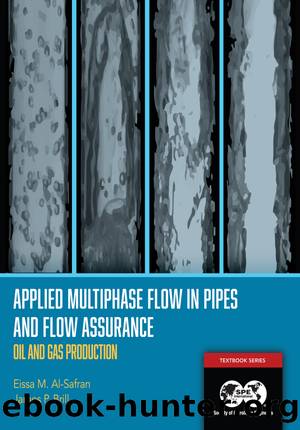Applied Multiphase Flow in Pipes and Flow Assurance by Eissa M. Al-Safran; James P. Brill;

Author:Eissa M. Al-Safran; James P. Brill;
Language: eng
Format: epub
Publisher: SPE
Fig. 8.9âThermal management system classifications.
Pipeline burial for preserving heat has the same principle as dry and wet insulation by reducing U, but is done by surrounding the pipeline with low-thermal-conductivity soil or rocks. Although heat preservation by pipeline burial is cost-effective and easy to implement for a single pipe compared to a PIP insulation system, its application is limited by soil properties, seafloor topography, and environment-related issues, especially in offshore applications. In addition, rocks with high heat capacity retain heat, behaving as a natural heat storage to prolong the cooldown period during shutdown.
Active Heating. Hot-fluid circulation and direct/indirect electrical heating are used as active heating methods to prevent cooldown of a nonflowing system during shutdown and thus prevent wax or hydrate formation. In addition, active heating can be used to increase the temperature of flowing fluids, thus reducing the chemical injection requirements and pipeline-pigging frequency. In direct electrical heating, heat is supplied directly to the flowing fluids through the pipe wall by an electrical cable carrying alternating current (AC). In this system, the heated pipe section is completely insulated from the surrounding seawater. In another direct electrical heating system, electrical communication with seawater is allowed through anodes, which requires the system to be earthed. An indirect electrical heating system supplies AC by an insulated electrical cable to an external tube, which is thermally coupled to the pipeline. The electrical cable is installed inside the external tube, generating heat on the inner surface of the external tube. Heat flows from the tube pipe wall, through the pipeline wall, and to the produced fluids (Hansen et al. 1999).
A hot-fluid circulation system can be envisioned as a very long heat exchanger with a bundle of pipes surrounded by a fluid-heating medium, and all are contained in one large insulated pipe, which is sleeved in a carrier pipe. The large pipe also contains heatup pipes through which a hot fluid is circulated, production pipes, and a fluid-heating medium to transfer heat from the heatup pipes to the production pipe by conduction, as shown in Fig. 8.11. The produced-fluids temperature gradient in a simple hot-fluid circulating system can be predicted by the equations presented in Chapter 7.
Pipeline Operation at Low Pressure. For low seafloor temperatures (4°C) and high heat transfer rate from hot produced fluids to the cold surrounding seawater, a very low pressure is required to stay away from the hydrate region, as shown in Fig. 8.8. For example, for a 0.6 specific gravity gas and a 4.4°C fluid temperature, the pressure must be less than 1.65 MPa (240 psi) to stay away from the hydrate formation region. This is a very low pressure for offshore pipelines. Therefore, operating a pipeline at low pressure may not be a suitable method to prevent hydrate formation when the pipeline is subjected to high external pressure and when production rate is desired to be unchanged. However, pipeline depressurization from higher operating pressure is often used after pipeline shutdown and before gas cooling to stay away from the hydrate formation region.
Download
This site does not store any files on its server. We only index and link to content provided by other sites. Please contact the content providers to delete copyright contents if any and email us, we'll remove relevant links or contents immediately.
| Automotive | Engineering |
| Transportation |
Whiskies Galore by Ian Buxton(40332)
Introduction to Aircraft Design (Cambridge Aerospace Series) by John P. Fielding(32338)
Small Unmanned Fixed-wing Aircraft Design by Andrew J. Keane Andras Sobester James P. Scanlan & András Sóbester & James P. Scanlan(32141)
Craft Beer for the Homebrewer by Michael Agnew(17447)
Turbulence by E. J. Noyes(7039)
The Complete Stick Figure Physics Tutorials by Allen Sarah(6638)
Kaplan MCAT General Chemistry Review by Kaplan(6054)
The Thirst by Nesbo Jo(5786)
Bad Blood by John Carreyrou(5769)
Learning SQL by Alan Beaulieu(5412)
Weapons of Math Destruction by Cathy O'Neil(5037)
Man-made Catastrophes and Risk Information Concealment by Dmitry Chernov & Didier Sornette(4736)
iGen by Jean M. Twenge(4702)
Digital Minimalism by Cal Newport;(4544)
Life 3.0: Being Human in the Age of Artificial Intelligence by Tegmark Max(4508)
Audition by Ryu Murakami(4099)
1,001 ASVAB Practice Questions For Dummies by Powers Rod(4039)
Electronic Devices & Circuits by Jacob Millman & Christos C. Halkias(4029)
Pale Blue Dot by Carl Sagan(4001)
